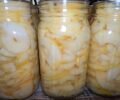Canning 101: How to Make Homemade Sauerkraut

Fresh cabbage
water
salt
sugar
White distilled vinegar
1
If you're new to the world of canning, making homemade sauerkraut is a great place to start. Whether you’re using a water bath or a pressure canner, the process is straightforward and rewarding. Sauerkraut not only tastes delicious but is also beneficial for your gut health. Here's a step-by-step guide to help you make your own sauerkraut, just like grandma used to do.

2
What You'll Need
Fresh cabbage
Sterile quart jars
Hot water
Canning salt
Sugar
White distilled vinegar
A food processor or knife for shredding
A kettle
Water bath canner
Preparation
Shred the Cabbage: Begin by shredding your fresh cabbage. You can use a food processor for convenience, but a knife works just as well.
Prepare the Jars: Ensure your quart jars are clean and sterile. This is crucial for food safety.
Pack the Cabbage: Pack the shredded cabbage into the jars. Press it down tightly but not too tightly—leave enough space for air bubbles to escape.
Adding Ingredients
Seasoning: Add one teaspoon each of canning salt, sugar, and white distilled vinegar to each jar. This combination not only helps preserve the cabbage but also gives sauerkraut its distinctive sour taste.
Fill with Hot Water: Pour hot water over the cabbage until it is fully submerged. Leave some space at the top to prevent the cabbage from touching the lid.
Canning Process
Remove Air Bubbles: Use a de-bubbler or a non-metallic utensil to release any trapped air bubbles in the jars.

3
Seal the Jars: Clean the rims of the jars with vinegar to ensure a good seal. Place the lids on the jars and screw on the rings tightly.
Water Bath Canning: Place the jars in a water bath canner. Ensure the water covers the jars by at least an inch. Bring the water to a rolling boil and process the jars for 20 minutes.
Post-Canning

4
Cooling and Storing: After 20 minutes, carefully remove the jars from the canner and let them cool. Once cooled, check the seals, clean the jars, and store them in a cool, dark place. Allow the sauerkraut to ferment in the jars for about four weeks before consuming.
Enjoying Your Sauerkraut
Homemade sauerkraut can be enjoyed in various ways. It's a great addition to hot dogs, sausages, or as a side dish. Not only does it enhance the flavor of your meals, but it also adds a healthy probiotic boost to your diet.

5
Next Steps
Once you’ve mastered sauerkraut, consider expanding your canning repertoire. Canning beans, for instance, is another simple and cost-effective way to stock your pantry with nutritious, homemade food.

6
Final Tips
Always ensure your jars, lids, and equipment are sterile to prevent contamination.
Adjust the amount of cabbage based on the size of your canning jars.
Experiment with different seasonings to customize your sauerkraut to your taste.
Canning is a delightful and practical hobby that can save you money and provide your family with delicious, homemade foods. Start with this easy sauerkraut recipe, and soon you'll be ready to explore more canning adventures. Happy canning!

Ingredients
Fresh cabbage
water
salt
sugar
White distilled vinegar
Directions
1
If you're new to the world of canning, making homemade sauerkraut is a great place to start. Whether you’re using a water bath or a pressure canner, the process is straightforward and rewarding. Sauerkraut not only tastes delicious but is also beneficial for your gut health. Here's a step-by-step guide to help you make your own sauerkraut, just like grandma used to do.

2
What You'll Need
Fresh cabbage
Sterile quart jars
Hot water
Canning salt
Sugar
White distilled vinegar
A food processor or knife for shredding
A kettle
Water bath canner
Preparation
Shred the Cabbage: Begin by shredding your fresh cabbage. You can use a food processor for convenience, but a knife works just as well.
Prepare the Jars: Ensure your quart jars are clean and sterile. This is crucial for food safety.
Pack the Cabbage: Pack the shredded cabbage into the jars. Press it down tightly but not too tightly—leave enough space for air bubbles to escape.
Adding Ingredients
Seasoning: Add one teaspoon each of canning salt, sugar, and white distilled vinegar to each jar. This combination not only helps preserve the cabbage but also gives sauerkraut its distinctive sour taste.
Fill with Hot Water: Pour hot water over the cabbage until it is fully submerged. Leave some space at the top to prevent the cabbage from touching the lid.
Canning Process
Remove Air Bubbles: Use a de-bubbler or a non-metallic utensil to release any trapped air bubbles in the jars.

3
Seal the Jars: Clean the rims of the jars with vinegar to ensure a good seal. Place the lids on the jars and screw on the rings tightly.
Water Bath Canning: Place the jars in a water bath canner. Ensure the water covers the jars by at least an inch. Bring the water to a rolling boil and process the jars for 20 minutes.
Post-Canning

4
Cooling and Storing: After 20 minutes, carefully remove the jars from the canner and let them cool. Once cooled, check the seals, clean the jars, and store them in a cool, dark place. Allow the sauerkraut to ferment in the jars for about four weeks before consuming.
Enjoying Your Sauerkraut
Homemade sauerkraut can be enjoyed in various ways. It's a great addition to hot dogs, sausages, or as a side dish. Not only does it enhance the flavor of your meals, but it also adds a healthy probiotic boost to your diet.

5
Next Steps
Once you’ve mastered sauerkraut, consider expanding your canning repertoire. Canning beans, for instance, is another simple and cost-effective way to stock your pantry with nutritious, homemade food.

6
Final Tips
Always ensure your jars, lids, and equipment are sterile to prevent contamination.
Adjust the amount of cabbage based on the size of your canning jars.
Experiment with different seasonings to customize your sauerkraut to your taste.
Canning is a delightful and practical hobby that can save you money and provide your family with delicious, homemade foods. Start with this easy sauerkraut recipe, and soon you'll be ready to explore more canning adventures. Happy canning!

Leave a Review
Please log in or register for a new account in order to leave a review.










